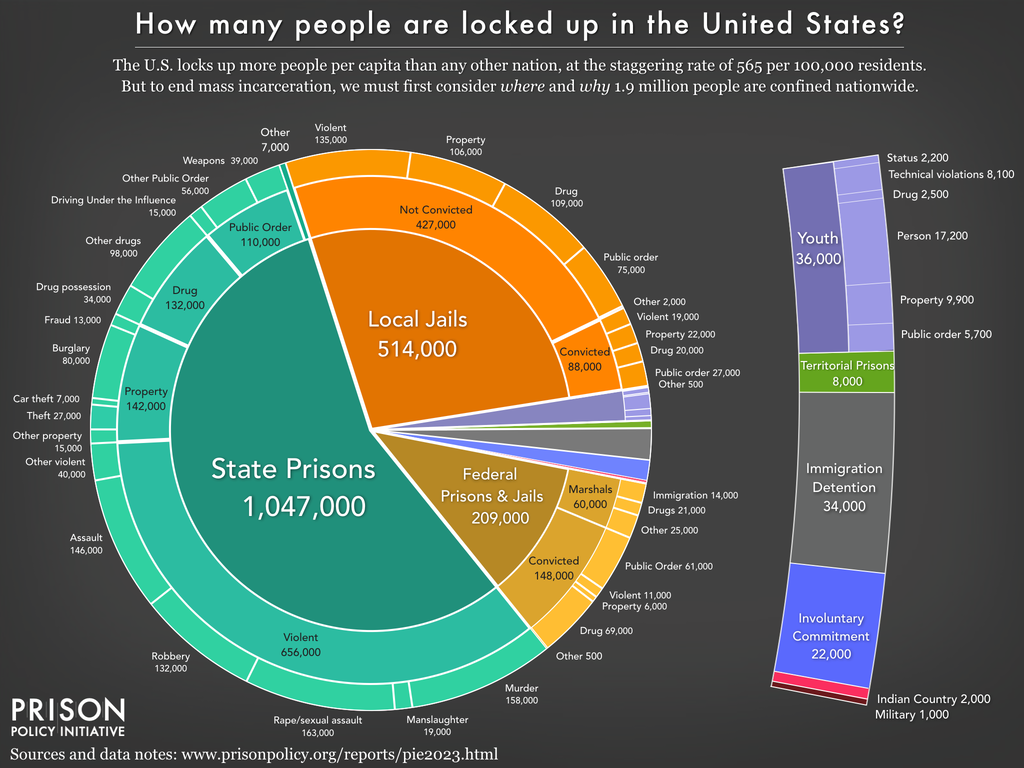New report Mass Incarceration: The Whole Pie 2023 shows that as the pandemic subsides, criminal legal system returning to “business as usual”
30 visualizations expose long-standing truths about mass incarceration in the U.S. and highlight the need for change
March 14, 2023
Today, the Prison Policy Initiative released Mass Incarceration: The Whole Pie 2023, its flagship report, which provides the most comprehensive view of how many people are locked up in the U.S., in what kinds of facilities, and why. It pieces together the most recent national data on state prisons, federal prisons, local jails, and other systems of confinement to provide a snapshot of mass incarceration in the U.S.

Highlights from the report include:
- Prison populations are starting to rebound. Although prison populations are still lower than they’ve been in decades, prison populations are beginning to increase as pandemic-related slowdowns in the criminal legal system are no longer driving down prison admissions. Additionally, officials continue to release fewer people from prison than before the pandemic.
- Recent claims about increasing crime are not supported by data. Crime rates remain at near historic lows. However, some in law enforcement and on the right have sought to blame changes to the criminal legal system — such as bail reform, changes to police budgets, or electing “progressive” prosecutors — for increases in some crime rates since the start of the pandemic. However, these claims are not supported by the evidence: murder rates were an average of 40% higher in “red” states compared to blue states in 2020, police budgets have recently increased in the vast majority of cities and counties in the country, and places that did not implement any of these reforms also saw increases in crime rates.
- In total, roughly 1.9 million people are incarcerated in the United States, 803,000 people are on parole, and a staggering 2.9 million people are on probation.
“The pandemic presented government leaders with the chance to turn the page on the era of mass incarceration, but the emerging data show that they largely squandered this opportunity,” said Wendy Sawyer, Research Director for the Prison Policy Initiative and co-author of the report. “While incarceration rates dropped quickly at the start of the pandemic, this was the result of pandemic-related slowdowns rather than any deliberate or decisive action by elected leaders. It is disappointing, but not surprising that prison populations are already beginning to creep up again.”
The report includes 30 visualizations of criminal justice data, exposing other long-standing truths about incarceration in the U.S.:
- The U.S. continues to lock up hundreds of thousands of people pretrial, and therefore legally innocent, every day.
- Black people are still overrepresented behind bars, making up about 38% of the prison and jail population and only 12% of U.S. residents.
- Harsh sentences don’t deter violent crime, and most victims don’t support them. Contrary to popular narratives, most victims of violence prefer investments in violence prevention and alternative ways of holding people accountable rather than more incarceration.
- At least 113 million adults in the U.S. (roughly 45%) have a family member who has been incarcerated, and 79 million people have a criminal record, revealing the ripple effects of locking up millions of people every day.
“As our society transitions to a new ‘post-pandemic’ normal, we are seeing a return to business as usual as officials are beginning to abandon positive practices implemented in response to the pandemic,” said Sawyer. “The size of The Whole Pie should serve as a wakeup call for both the government and the public that if we don’t take meaningful action to disrupt the real drivers of mass incarceration — poverty, criminalization, low levels of investment in services that meet people’s needs, draconian policies that fuel the systems’ expansion — then the U.S. will retain the dubious distinction as the top incarcerator in the world.”
Read the full report, with detailed data visualizations at: https://www.prisonpolicy.org/reports/pie2023.html.



